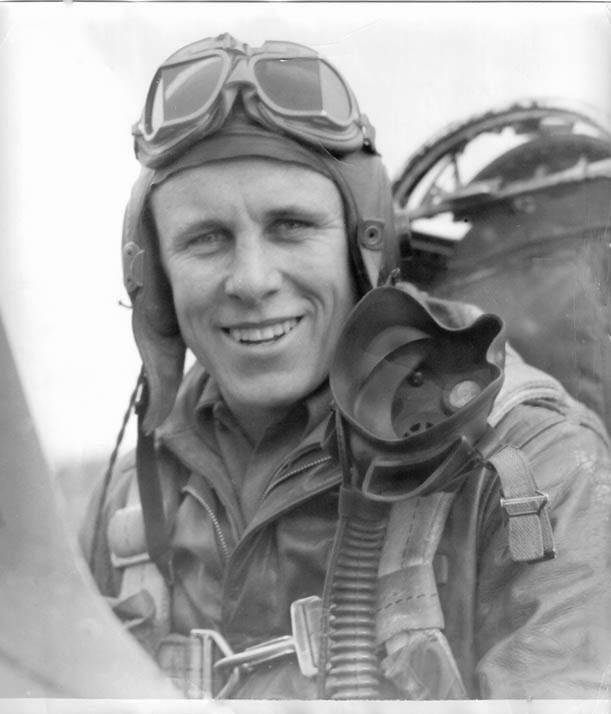You know, you just never know do you?
"I'd just made one pass (dropping bombs). One pass on a grouping of tanks that were staging for the Bulge. (I can remember) pulling up over the woods, the trees, the snow and that 109 coming at me, guns sparkling—and then I saw them all! I'd never seen so many (German airplanes) in my life!"
BANG!...zip zip BANG! Machine gun bullets perforated "Our Mary's" thin skin as easily as an ice pick slammed into a soda can. But it was the slower firing nose cannon that did the lethal damage; the German's 20mm shells exploded into the starboard wing root and cowl, severing oil lines and destroying eight of the airplane engine's eighteen cylinders.
Considering that the enemies closed at a collective rate of about 600 miles per hour and the German's bullets were traveling about four times faster, the moment began and ended in a blink of time.
"There was no time to really think. When I first saw (the particular 109 angling in from Ed's one o'clock position) I turned to face him head on. Then, his nose started sparkling and then Bang! The engine started to 'chug' and oil blew all over my windscreen. I couldn't see and I knew I'd been terribly hit."
Ed announced on the radio his situation and the flight leader immediately commanded, "Get out'a here! Two-seventy, West!" Of course, there was no argument on Ed's part. He used the remaining airspeed to carve a path Westward in the hope of making the front line of Belgium before he would have to bail out or belly in.
"Our base at St. Trond was close to the bomb line (Front). In fact, at the time, we were the closest forward field. So, getting to the front line meant that I probably wouldn't be taken POW."
However, with a trail of inky smoke behind, "Our Mary" was a conspicuous point in the sky and drew the attention of more Germans.
"I was looking. Over my shoulders. And I saw these two 109s coming up behind me. I was going slow, but as fast as I could. I could see they were criss-crossing in an effort to slow down. I settled into my seat and waited. I was dead or going to be a POW for certain. But when the bullets didn't come, I looked out to the sides. And there they were."
"Where?" I asked.
"Close. Close formation. Just off my wingtips."
Stop for moment to let this sink in. Especially in air combat, there's practically no opportunity to really see your enemy for their true shape and personality. The transactions of war happen in flashes, sparks. There, bang! gone. It had to have been a surreal moment, being so close to the enemy and so powerless.
Compared to the blunt-nosed bulk of a P-47, the Me-109 was an elegant wisp. In fact, there was over a ton and a half difference in weight between the two. Of course, that extra weight of heft, armor and American engineering had just prolonged Ed's life. But one must appreciate the eerie sight of these two wholly foreign beasts, so close and so lethal, just a few feet away.
Seconds ticked by. Ed's airplane shuddered, rattled...and all the while, the ground below passed by at an interminably slow pace. Ed was bewildered.
"What were you thinking?!"
"Hmmm," he paused, then answered in the questioning voice of a man who's unsure of his answer. "Whether I was going to live? Die? Will I make it to the bomb line?" Ed laughed. "Here I was, being escorted by two Messerschmitt 109s!"
"And then what?!"
"We just crossed the bomb line and I looked over (at the German pilot off Ed's right wing) and he made the OK sign. Then, he peeled off. I looked (to my left) and he peeled off too."
"And then what?!"
"I was able to make it back to base."
With an obscured windscreen and rattled motor, Ed brought "Our Mary" to landing at his base. As if from a movie, the engine seized solid and coaxed the airplane to a silent stop.
"I was in shock."
Ed describes the debriefing as nervous, he was understandably, rather shaken up by the blenderized emotions of the past hour. When I asked him about the reactions of his squadron mates, he remarked that they were—as expected—fascinated but ultimately, such acts of Grace were not uncommon in war. Ed explained that though his extraordinary store was certainly momentous to him, they were one of the quirks of combat that happen.
Ed finished out the war, flying his 65th and final combat mission on May 7, 1945 (the war ended on the 8th).
Fast forward to the 21st Century.
The picture above is from the website of West Chester University. Actually, it's a pretty interesting page because it's the one that describes the "Dr. Edwin Cottrell Entrepreneurial Leadership Center." And of course, that's Ed pointing to a picture of his WWII self.
After WWII, Ed earned his doctorate in Health and Physical Science from Penn State and settled at West Chester University where, among a whole list of things, he became somewhat of a legend as a golf coach. Now, in case you're wondering, Ed didn't set out to create the ECELC as a monument to his ego. In fact, he didn't create it at all. The Center was a gift from a grateful former golf student who made good. Pretty cool, eh?
Over the years, I've learned that people who are especially good at motivating or encouraging others to be successful are also especially good communicators. They're clear, concise and, to a soul, positive. Asking the question, "Can you summarize your life's advice?" caused only a few seconds before replying, "Respect."
The next half hour was a wonderful discussion of what that actually meant. But for here, it simply means to recognize that an individual's work and actions ultimately reflects on others. I couldn't help but think about those two Luftwaffe pilots who, seventy years prior, decided to "Respect" as they did with Grace instead of condemnation.
Now...just to be clear, until humanity evolves to the next level, the Old Testament book of Ecclesiastes (3:1-8) expresses reality rather clearly—there is a time to kill, a time to heal. A time for war, a time for peace. A time to be born and a time to die. And in the mystery of cause-and-effect, who knows how and why stuff comes out the way it does!
But because two Luftwaffe pilots decided to Respect as they did, one man was able to Respect, too. Ed Cottrell is 93 years old and thinks about December 17 often; he wonders what was going on the minds of those two German pilots...
NOTE: Ed wanted me to make sure that anyone who reads this realizes that he was, "...just a scared 21 year old American hoping to stay alive. I hope youth and people in the the future will not forget how terrible war is and how it effects people's lives."
Note: Forgive the shameless plug but if you'd like to put a little Respect on your wall, click here. ("Our Mary" shows up towards the bottom of the page).
Stop there and have a look above. It's "Our Mary," the P-47 that Lt. Edwin Cottrell was flying on a fate-filled Sunday over northern continental Europe.
The Battle of the Bulge had just ignited; it was Hitler's audacious—but ultimately stupid—move to shock the Allies into negotiating terms of surrender. Yet, though he was in the thick of it, battle strategy wasn't on Lt. Cottrell's mind as he looked up and saw...look below.
Click the picture to see the guns firing.
BANG!...zip zip BANG! Machine gun bullets perforated "Our Mary's" thin skin as easily as an ice pick slammed into a soda can. But it was the slower firing nose cannon that did the lethal damage; the German's 20mm shells exploded into the starboard wing root and cowl, severing oil lines and destroying eight of the airplane engine's eighteen cylinders.
Considering that the enemies closed at a collective rate of about 600 miles per hour and the German's bullets were traveling about four times faster, the moment began and ended in a blink of time.
"There was no time to really think. When I first saw (the particular 109 angling in from Ed's one o'clock position) I turned to face him head on. Then, his nose started sparkling and then Bang! The engine started to 'chug' and oil blew all over my windscreen. I couldn't see and I knew I'd been terribly hit."
Ed announced on the radio his situation and the flight leader immediately commanded, "Get out'a here! Two-seventy, West!" Of course, there was no argument on Ed's part. He used the remaining airspeed to carve a path Westward in the hope of making the front line of Belgium before he would have to bail out or belly in.
"Our base at St. Trond was close to the bomb line (Front). In fact, at the time, we were the closest forward field. So, getting to the front line meant that I probably wouldn't be taken POW."
However, with a trail of inky smoke behind, "Our Mary" was a conspicuous point in the sky and drew the attention of more Germans.
"I was looking. Over my shoulders. And I saw these two 109s coming up behind me. I was going slow, but as fast as I could. I could see they were criss-crossing in an effort to slow down. I settled into my seat and waited. I was dead or going to be a POW for certain. But when the bullets didn't come, I looked out to the sides. And there they were."
"Where?" I asked.
"Close. Close formation. Just off my wingtips."
Stop for moment to let this sink in. Especially in air combat, there's practically no opportunity to really see your enemy for their true shape and personality. The transactions of war happen in flashes, sparks. There, bang! gone. It had to have been a surreal moment, being so close to the enemy and so powerless.
Compared to the blunt-nosed bulk of a P-47, the Me-109 was an elegant wisp. In fact, there was over a ton and a half difference in weight between the two. Of course, that extra weight of heft, armor and American engineering had just prolonged Ed's life. But one must appreciate the eerie sight of these two wholly foreign beasts, so close and so lethal, just a few feet away.
Seconds ticked by. Ed's airplane shuddered, rattled...and all the while, the ground below passed by at an interminably slow pace. Ed was bewildered.
"What were you thinking?!"
"Hmmm," he paused, then answered in the questioning voice of a man who's unsure of his answer. "Whether I was going to live? Die? Will I make it to the bomb line?" Ed laughed. "Here I was, being escorted by two Messerschmitt 109s!"
 |
| A 2 minute sketch. Ed assured me, the 109s got even closer than they're depicted here. |
"We just crossed the bomb line and I looked over (at the German pilot off Ed's right wing) and he made the OK sign. Then, he peeled off. I looked (to my left) and he peeled off too."
"And then what?!"
"I was able to make it back to base."
With an obscured windscreen and rattled motor, Ed brought "Our Mary" to landing at his base. As if from a movie, the engine seized solid and coaxed the airplane to a silent stop.
"I was in shock."
Ed describes the debriefing as nervous, he was understandably, rather shaken up by the blenderized emotions of the past hour. When I asked him about the reactions of his squadron mates, he remarked that they were—as expected—fascinated but ultimately, such acts of Grace were not uncommon in war. Ed explained that though his extraordinary store was certainly momentous to him, they were one of the quirks of combat that happen.
Ed finished out the war, flying his 65th and final combat mission on May 7, 1945 (the war ended on the 8th).
Fast forward to the 21st Century.
 |
| Screen-shot of the West Chester University web page highlighting Ed. |
After WWII, Ed earned his doctorate in Health and Physical Science from Penn State and settled at West Chester University where, among a whole list of things, he became somewhat of a legend as a golf coach. Now, in case you're wondering, Ed didn't set out to create the ECELC as a monument to his ego. In fact, he didn't create it at all. The Center was a gift from a grateful former golf student who made good. Pretty cool, eh?
Over the years, I've learned that people who are especially good at motivating or encouraging others to be successful are also especially good communicators. They're clear, concise and, to a soul, positive. Asking the question, "Can you summarize your life's advice?" caused only a few seconds before replying, "Respect."
The next half hour was a wonderful discussion of what that actually meant. But for here, it simply means to recognize that an individual's work and actions ultimately reflects on others. I couldn't help but think about those two Luftwaffe pilots who, seventy years prior, decided to "Respect" as they did with Grace instead of condemnation.
Now...just to be clear, until humanity evolves to the next level, the Old Testament book of Ecclesiastes (3:1-8) expresses reality rather clearly—there is a time to kill, a time to heal. A time for war, a time for peace. A time to be born and a time to die. And in the mystery of cause-and-effect, who knows how and why stuff comes out the way it does!
But because two Luftwaffe pilots decided to Respect as they did, one man was able to Respect, too. Ed Cottrell is 93 years old and thinks about December 17 often; he wonders what was going on the minds of those two German pilots...
 |
| Ed Cottrell, circa 1944. |
Note: Forgive the shameless plug but if you'd like to put a little Respect on your wall, click here. ("Our Mary" shows up towards the bottom of the page).

























